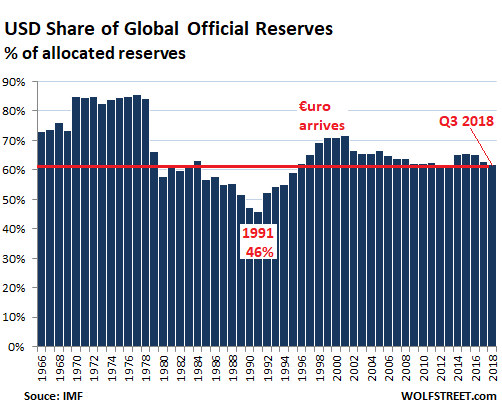US Dollar Status as Global Reserve Currency?
So, how hot is the Chinese Renminbi? And is the euro dead yet?
The US dollar’s role as global reserve currency is defined by the amounts of US dollar-denominated assets – US Treasury securities, corporate bonds, etc. – that central banks other than the Fed are holding in their foreign exchange reserves. To diminish the dollar’s role as a global reserve currency, these central banks would have to dump the dollar.
So, let’s see. Total global foreign exchange reserves, in all currencies, came in at $11.4 trillion in the third quarter, according to the IMF’s data on “Currency Composition of Official Foreign Exchange Reserves” (COFER), released this morning. The amount of USD-denominated exchange reserves was $6.63 trillion. This amounted to 61.9% of total foreign exchanges reserves held by central banks, the lowest since 2013:

In the chart above, note the arrival of the euro. It became an accounting currency in the financial markets in 1999, replacing the European Currency Unit. Euro banknotes and coins appeared on January 1, 2002. At the end of 2001, the dollar’s share of reserve currencies was 71.5%. In 2002, it dropped to 66.5%. Now it’s down to 62.2%.
The euro replaced a gaggle of European currencies that had been held as foreign exchange reserves, on top of which was the Deutsche mark.
In Q3, the euro’s share rose to 20.5%, the highest since Q4 2014. The creation of the euro was an effort to reduce the dollar’s hegemony. At the time, the theme was that the euro would reach “parity” with the dollar. But the euro Debt Crisis ended that dream.
The other major reserve currencies don’t have a “major” share. The combined share of the dollar and the euro, at 82.4%, leaves only 17.6% for all other currencies combined. The two currencies with the largest share in that group are the Japanese yen, at 5.0%, and the UK pound sterling, at 4.5%.
…click on the above link to read the rest of the article…